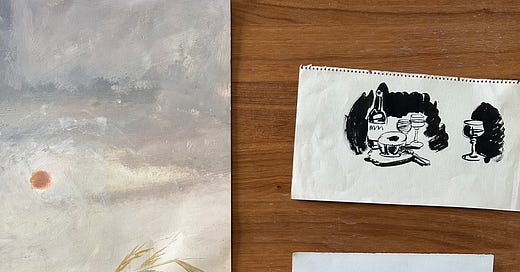The Artist And The Art Collector
I went to an estate sale and I brought home more than belongings
On a drizzly Friday morning in January, I waited in line to enter the estate of prominent Portland artist Doug Lynch (not to be confused with filmmaker David Lynch). About 40 other people stood in front of me. Men with gray hair and round wire frames, a trio of women about my age wearing dad hats and tote bags, someone in an oversized yellow raincoat with a child-sized backpack. Each person came prepared with IKEA bags or bins or baskets in hopes of filling them with precious finds from the three-story home. Probably like everyone else, I learned about the sale on estatesalefinder.com, where I often look for secondhand furniture and home goods. Following my curiosity that morning to Northwest Portland, I couldn’t predict I’d end up waiting in the rain for three hours.
I spent some of my time in line learning about Doug and his wife, Alix, from news stories, gallery blurbs, and obituaries. Doug was a graphic artist whose most iconic piece is still in the Timberline Lodge. In the 1930s, at age 24, he was commissioned to design, carve, and paint nine large linoleum murals for the resort’s cafeteria on Mount Hood. He spent most of his career freelancing and teaching at the Portland Museum School, and he even owned a studio in the Galleria. One of his other significant projects was designing Portland’s city flag, with its blocks of green and intersecting blue, yellow, and white lines.
His wife was equally interesting. Alix was also an owner of The Design Source in the Galleria, where she occupied the studio’s front space with an import boutique. She curated work from artisans around the world, including delicate Mexican straw Christmas ornaments and intricate colorful tapestries from Ethiopia, Peru, and India. Alix died in 2022, outliving her husband by 18 more years.
In a 2004 interview with the Oregonian only a few months before his death at age 96, Doug said:
"I didn't become an artist. I always was, from the time I was a child — everybody put pencils in my hand, colored chalk and all that stuff — and so there was no transition from the point when I was whatever I was as a child to becoming an artist. It was just a continuous process.”
My toes were numb in my leather boots by the time I was finally allowed inside. I snuck upstairs first to avoid the crowd on the first floor, but upstairs was full too, with people flipping through stacks of books and piles of artwork. Four bedrooms overflowed with their life’s-worth of collectibles. One room was lined wall to wall, floor to ceiling with books, magazines, and records. Another room burst with textiles. Even the end of the hallway was stacked with things. One table was covered entirely in fabric, beaded, and felt ornaments. On another table, crusted paintbrushes clustered in jars and contorted tubes of used pastels clumped together. In every corner of the house, containers held posters and sketches and brochures. People lingered, contemplating their piles and adding more.
Looking at the displays of their belongings, it was clear that the Lynches lived a beautiful and full life, not just because they were surrounded by so many exquisite things, but because each item represented a memory, which we could try to reconstruct but would never fully know.
I came away with a few items: a brown checkered blanket, a few yards of striped and gingham fabrics, a sketch of a wine bottle and stemmed glasses, a two-foot watercolor of a sunset over a prairie, a block print of a lotus flower, a hand basket, a pocket-sized book about West Coast artists, and, just because, a green fabric parrot ornament.
The line was just as long as it had been and it was still dripping wet when I reemerged outside. How odd a feeling to covet someone else’s belongings enough to wait for three hours in the cold. There’s definitely something capitalistic and gluttonous worth discussing. But I prefer to focus on our obsession with art, artists, and the things created and collected. That’s why I went, after all.
Walking through their house reminded me that being an artist, being a writer means surrounding yourself with art and writing. Call it inspiration, call it influence. Without consuming it, digesting it, observing it, critiquing it, we have no perspective. We are only as creative as our surroundings.
To be an artist is to be an art collector.
What are you collecting?





